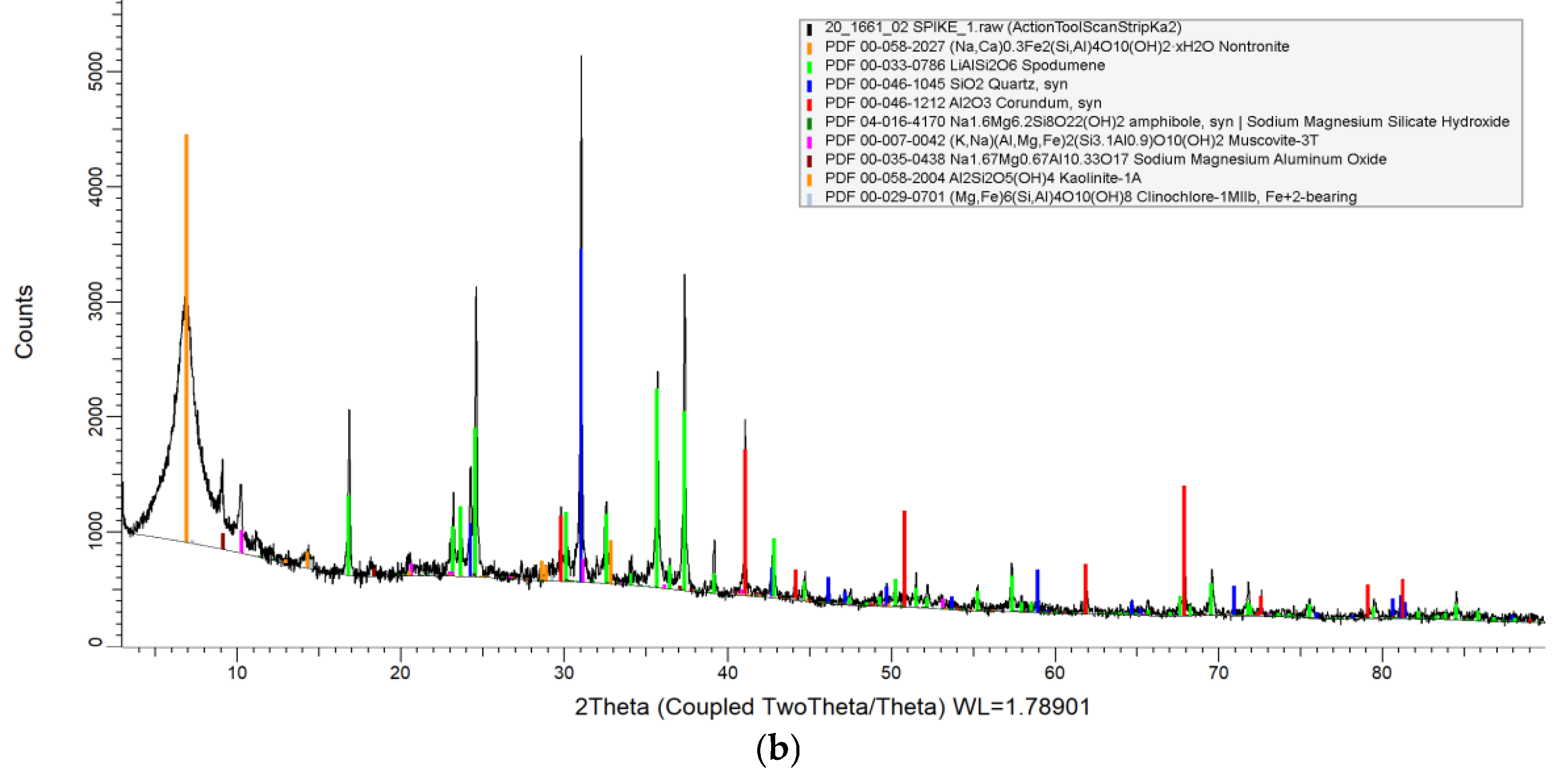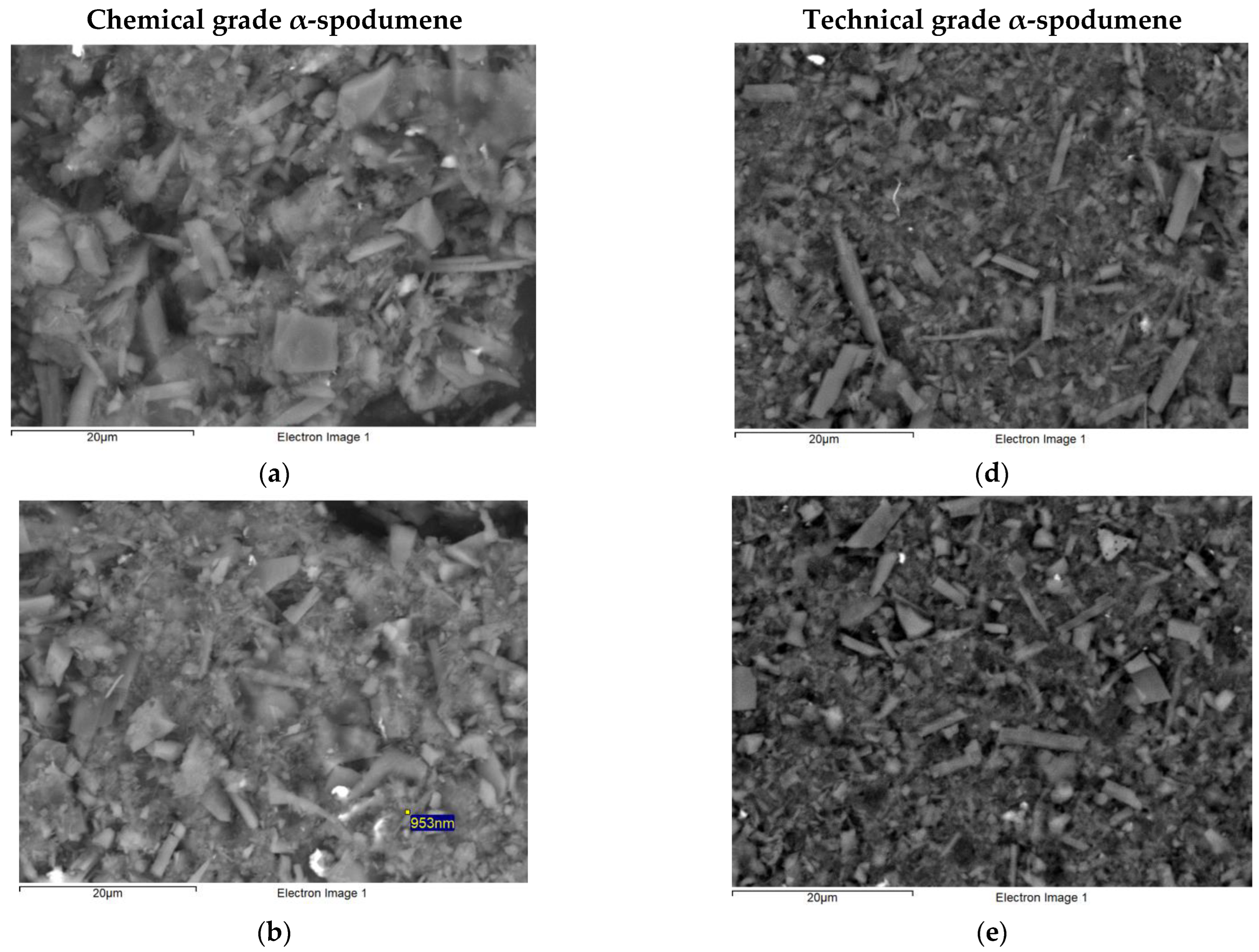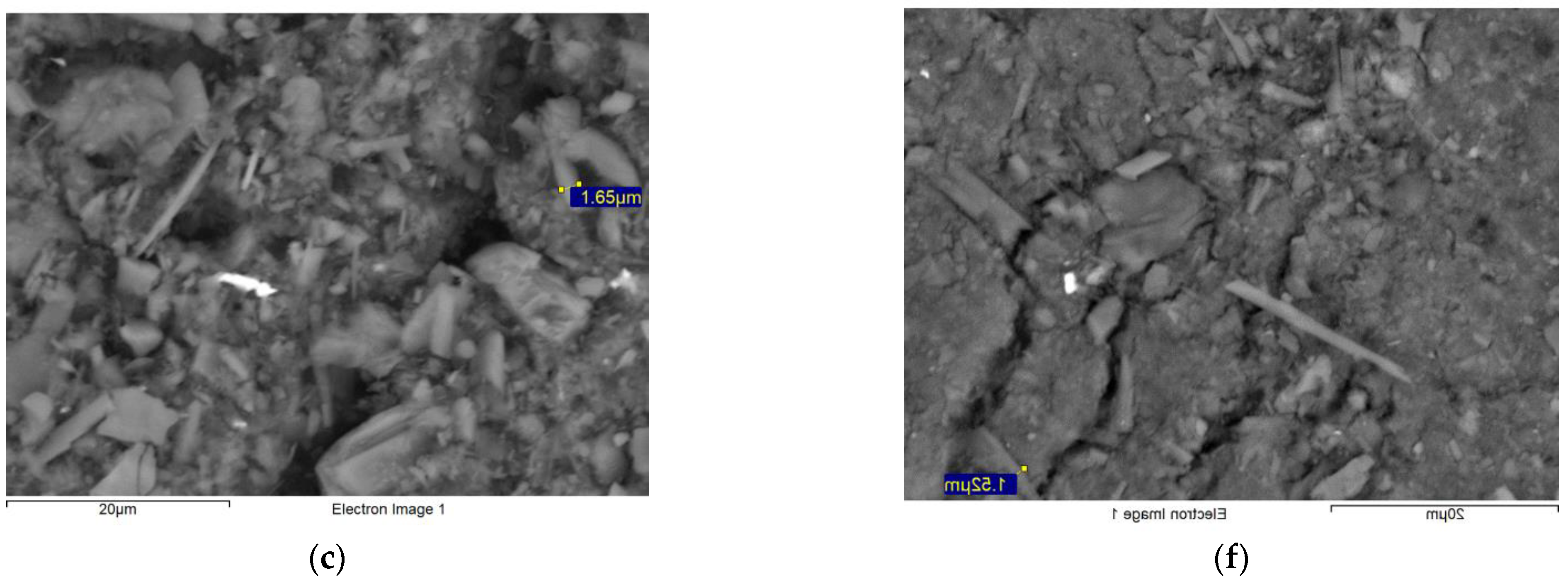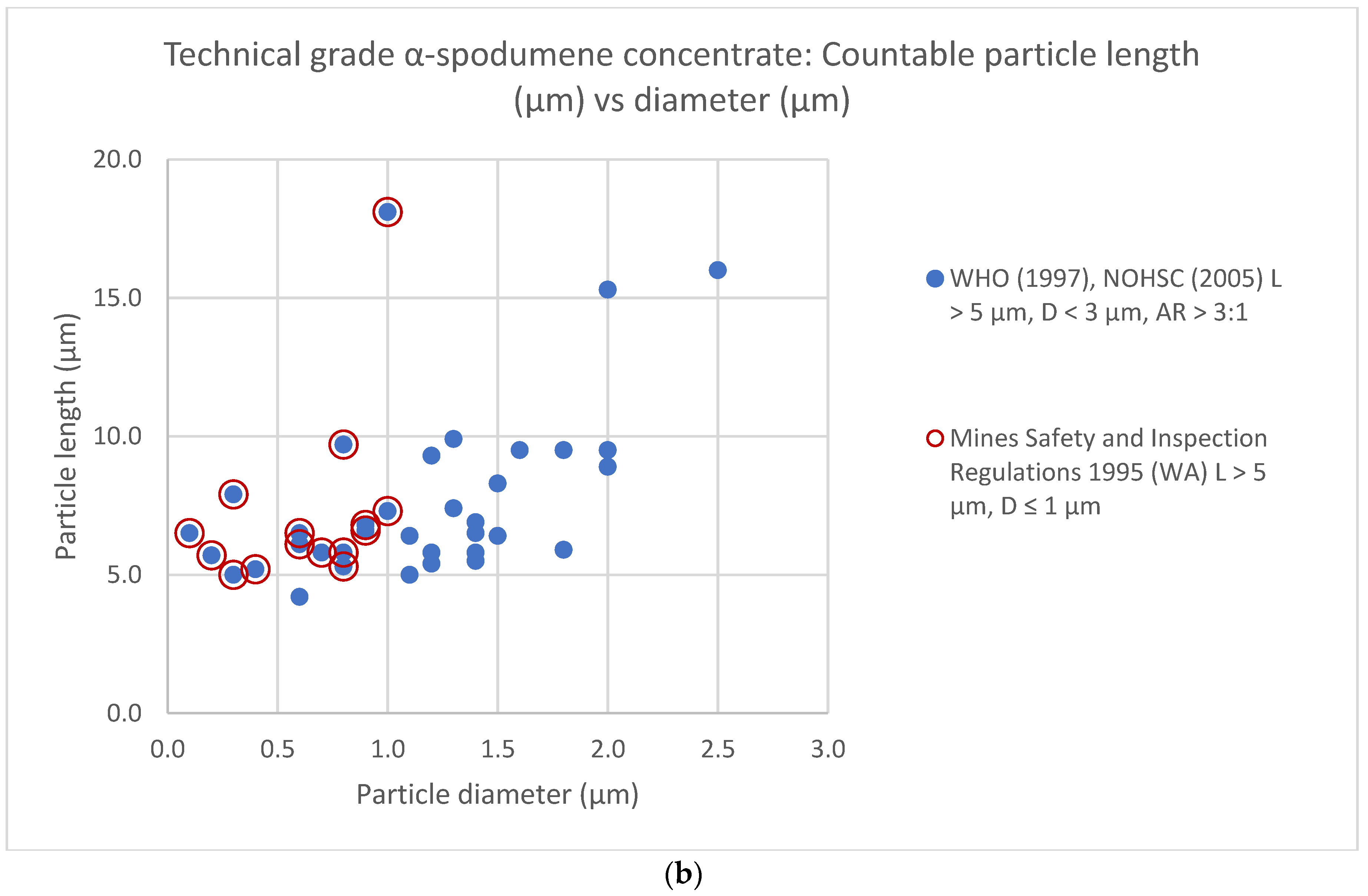Pathogenic Potential of Respirable Spodumene Cleavage Fragments following Application of Regulatory Counting Criteria for Asbestiform Fibres
Abstract
1. Introduction
2. Materials and Methods
2.1. Materials
2.2. Methods
2.2.1. Mineral Characterisation
2.2.2. Measurement of Cleavage Fragment Sizes Use a Scanning Electron Microscope (SEM)
3. Results
3.1. Mineral Characterisation
3.2. Identification and Measurement of Countable Particles Using SEM
4. Discussion
5. Conclusions
Author Contributions
Funding
Institutional Review Board Statement
Informed Consent Statement
Data Availability Statement
Acknowledgments
Conflicts of Interest
References
- Peltosaari, O.; Tanskanen, P.; Heikkinen, E.-P.; Fabritius, T. α→γ→β-phase transformation of spodumene with hybrid microwave and conventional furnaces. Miner. Eng. 2015, 82, 54–60. [Google Scholar] [CrossRef]
- Zhu, G.; Wang, X.; Li, E.; Wang, Y.; Miller, J.D. Wetting characteristics of spodumene surfaces as influenced by collector adsorption. Miner. Eng. 2019, 130, 117–128. [Google Scholar] [CrossRef]
- Paton, C.; Barnes, T.R.; Shingleton-Smith, A.; McAllister-Williams, R.H.; Kirkbride, J.; Jones, P.B.; McIntyre, S. Lithium in bipolar and other affective disorders: Prescribing practice in the UK. J. Psychopharmacol. 2010, 24, 1739–1746. [Google Scholar] [CrossRef] [PubMed]
- Xu, L.; Peng, T.; Tian, J.; Lu, Z.; Hu, Y.; Sun, W. Anisotropic surface physicochemical properties of spodumene and albite crystals: Implications for flotation separation. Appl. Surf. Sci. 2017, 426, 1005–1022. [Google Scholar] [CrossRef]
- Salakjani, N.K.; Singh, P.; Nikoloski, A.N. Mineralogical transformations of spodumene concentrate from Greenbushes, Western Australia. Part 1: Conventional heating. Miner. Eng. 2016, 98, 71–79. [Google Scholar] [CrossRef]
- Aylmore, M.G.; Merigot, K.; Rickard, W.D.; Evans, N.J.; McDonald, B.J.; Catovic, E.; Spitalny, P. Assessment of a spodumene ore by advanced analytical and mass spectrometry techniques to determine its amenability to processing for the extraction of lithium. Miner. Eng. 2018, 119, 137–148. [Google Scholar] [CrossRef]
- Rai, B.; Sathish, P.; Tanwar, J.; Pradip; Moon, K.; Fuerstenau, D. A molecular dynamics study of the interaction of oleate and dodecylammonium chloride surfactants with complex aluminosilicate minerals. J. Colloid Interface Sci. 2011, 362, 510–516. [Google Scholar] [CrossRef]
- Azevedo, M.; Campagnol, N.; Hagenbruch, T.; Hoffman, K.; Lala, A.; Ramsbottom, O. Lithium and Cobalt: A Tale of Two Commodities. McKinsey & Company. 2018. Available online: https://www.mckinsey.com/~/media/mckinsey/industries/metals%20and%20mining/our%20insights/lithium%20and%20cobalt%20a%20tale%20of%20two%20commodities/lithium-and-cobalt-a-tale-of-two-commodities.ashx (accessed on 5 May 2022).
- Karrech, A.; Azadi, M.; Elchalakani, M.; Shahin, M.; Seibi, A. A review on methods for liberating lithium from pegmatities. Miner. Eng. 2020, 145, 106085. [Google Scholar] [CrossRef]
- Filippov, L.; Farrokhpay, S.; Lyo, L.; Filippova, I. Spodumene Flotation Mechanism. Minerals 2019, 9, 372. [Google Scholar] [CrossRef]
- Swain, B. Recovery and recycling of lithium: A review. Sep. Purif. Technol. 2017, 172, 388–403. [Google Scholar] [CrossRef]
- Salakjani, N.K.; Nikoloski, A.N.; Singh, P. Mineralogical transformations of spodumene concentrate from Greenbushes, Western Australia. Part 2: Microwave heating. Miner. Eng. 2017, 100, 191–199. [Google Scholar] [CrossRef]
- Tadesse, B.; Makuei, F.; Albijanic, B.; Dyer, L. The beneficiation of lithium minerals from hard rock ores: A review. Miner. Eng. 2019, 131, 170–184. [Google Scholar] [CrossRef]
- Zhu, G.; Wang, Y.; Liu, X.; Yu, F.; Lu, D. The cleavage and surface properties of wet and dry ground spodumene and their flotation behavior. Appl. Surf. Sci. 2015, 357, 333–339. [Google Scholar] [CrossRef]
- United States Geological Survey. Mineral Commodity Summaries. 2022. Available online: https://pubs.usgs.gov/periodicals/mcs2022/mcs2022.pdf (accessed on 16 May 2022).
- Bale, M.; May, A. Processing of ores to produce tantalum and lithium. Miner. Eng. 1989, 2, 299–320. [Google Scholar] [CrossRef]
- Xu, L.; Hu, Y.; Wu, H.; Tian, J.; Liu, J.; Gao, Z.; Wang, L. Surface crystal chemistry of spodumene with different size fractions and implications for flotation. Sep. Purif. Technol. 2016, 169, 33–42. [Google Scholar] [CrossRef]
- Zhu, G.-L.; Wang, Y.-H.; Wang, X.-M.; Miller, J.D.; Lu, D.-F.; Zheng, X.-Y.; Zhao, Y.-H.; Zheng, H.-T. Effects of grinding environment and lattice impurities on spodumene flotation. Trans. Nonferrous Met. Soc. China 2019, 29, 1527–1537. [Google Scholar] [CrossRef]
- National Institute for Occupational Safety and Health. Current Intelligence Bulletin 62: Asbestos Fibers and Other Elongate Mineral Particles: State of the Science and Roadmap for Research (Publication No. 2011–159). U.S. Department of Health and Human Services. 2011. Available online: https://www.cdc.gov/niosh/docs/2011-159/pdfs/2011-159.pdf (accessed on 16 May 2022).
- Ilgren, E.B. The Biology of Cleavage Fragments: A Brief Synthesis and Analysis of Current Knowledge. Indoor Built Environ. 2004, 13, 343–356. [Google Scholar] [CrossRef]
- Belardi, G.; Vignaroli, G.; Trapasso, F.; Pacella, A.; Passeri, D. Detecting asbestos fbres and cleavage fragments produced afer mechanical tests on ophiolite rocks: Clues for the asbestos hazard evaluation. J. Mediterr. Earth Sci. 2018, 10, 63–78. [Google Scholar] [CrossRef]
- Strohmeier, B.R.; Huntington, J.C.; Bunker, K.L.; Sanchez, M.S.; Allison, K.; Lee, R.J. What is asbestos and why is it important? Challenges of defining and characterizing asbestos. Int. Geol. Rev. 2010, 52, 801–872. [Google Scholar] [CrossRef]
- Dorling, M.; Zussman, J. Characteristics of asbestiform and non-asbestiform calcic amphiboles. Lithos 1987, 20, 469–489. [Google Scholar] [CrossRef]
- Bernstein, D.; Castranova, V.; Donaldson, K.; Fubini, B.; Hadley, J.; Hesterberg, T.; Kane, A.; Lai, D.; McConnell, E.E.; Muhle, H.; et al. Testing of Fibrous Particles: Short-Term Assays and Strategies. Inhal. Toxicol. 2005, 17, 497–537. [Google Scholar] [CrossRef] [PubMed]
- Korchevskiy, A.A.; Wylie, A.G. Dimensional determinants for the carcinogenic potency of elongate amphibole particles. Inhal. Toxicol. 2021, 33, 244–259. [Google Scholar] [CrossRef] [PubMed]
- Stanton, M.F.; Layard, M.; Tegeris, A.; Miller, E.; May, M.; Morgan, E.; Smith, A. Relation of Particle Dimension to Carcinogenicity in Amphibole Asbestoses and Other Fibrous Minerals. Gynecol. Oncol. 1981, 67, 965–975. [Google Scholar] [CrossRef]
- Wylie, A.G.; Korchevskiy, A.; Segrave, A.M.; Duane, A. Modeling mesothelioma risk factors from amphibole fiber dimensionality: Mineralogical and epidemiological perspective. J. Appl. Toxicol. 2020, 40, 515–524. [Google Scholar] [CrossRef] [PubMed]
- Fubini, B.; Fenoglio, I. Toxic Potential of Mineral Dusts. Elements 2007, 3, 407–414. [Google Scholar] [CrossRef]
- Li, Q.; Peng, W.; Zhang, Z.; Pei, X.; Sun, Z.; Ou, Y. A phycocyanin derived eicosapeptide attenuates lung fibrosis development. Eur. J. Pharmacol. 2021, 908, 174356. [Google Scholar] [CrossRef]
- Gualtieri, A.F.; Mossman, B.T.; Roggli, V.L. Chapter 15: Towards a general model for predicting the toxicity and pathogenicity of mineral fibres. In Mineral Fibres: Crystal Chemistry, Chemical-Physical Properties, Biological Interaction and Toxicity; Gualtieri, A.F., Ed.; European Mineralogical Union: London, UK, 2017; Volume 18, pp. 501–532. [Google Scholar] [CrossRef]
- Roggli, V.L. Measuring EMPs in the lung what can be measured in the lung: Asbestiform minerals and cleavage fragments. Toxicol. Appl. Pharmacol. 2018, 361, 14–17. [Google Scholar] [CrossRef]
- Boulanger, G.; Andujar, P.; Pairon, J.-C.; Billon-Galland, M.-A.; Dion, C.; Dumortier, P.; Brochard, P.; Sobaszek, A.; Bartsch, P.; Paris, C.; et al. Quantification of short and long asbestos fibers to assess asbestos exposure: A review of fiber size toxicity. Environ. Health 2014, 13, 59. [Google Scholar] [CrossRef]
- World Health Organization. Determination of Airborne Fibre Number Concentrations: A Recommended Method, by Phase-Contrast Optical Microscopy (Membrane Filter Method). 1997. Available online: https://apps.who.int/iris/bitstream/handle/10665/41904/9241544961.pdf?sequence=1&isAllowed=y (accessed on 5 May 2022).
- National Occupational Health and Safety Commission. Guidance Note on the Membrane Filter Method for Estimating Airborne Asbestos Fibres (2nd Edn) (NOHSC:3003). Australian Government National Occupational Health and Safety Commission. 2005. Available online: https://www.safeworkaustralia.gov.au/system/files/documents/1702/guidancenote_membranefiltermethodforestimatingairborneasbestosfibres_2ndedition_nohsc3003-2005_pdf.pdf (accessed on 5 May 2022).
- Berman, D.W.; Crump, K.S. Final Draft: Technical Support Document for a Protocol to Assess Asbestos-Related Risk (USEPA #9345.4-06). U.S. Environmental Protection Agency. Available online: https://nepis.epa.gov/Exe/ZyNET.exe/901D0S00.TXT?ZyActionD=ZyDocument&Client=EPA&Index=2000+Thru+2005&Docs=&Query=&Time=&EndTime=&SearchMethod=1&TocRestrict=n&Toc=&TocEntry=&QField=&QFieldYear=&QFieldMonth=&QFieldDay=&IntQFieldOp=0&ExtQFieldOp=0&XmlQuery=&File=D%3A%5Czyfiles%5CIndex%20Data%5C00thru05%5CTxt%5C00000012%5C901D0S00.txt&User=ANONYMOUS&Password=anonymous&SortMethod=h%7C-&MaximumDocuments=1&FuzzyDegree=0&ImageQuality=r75g8/r75g8/x150y150g16/i425&Display=hpfr&DefSeekPage=x&SearchBack=ZyActionL&Back=ZyActionS&BackDesc=Results%20page&MaximumPages=1&ZyEntry=1&SeekPage=x&ZyPURL (accessed on 6 May 2022).
- Chatfield, E.J. Measurement of elongate mineral particles: What we should measure and how do we do it? Toxicol. Appl. Pharmacol. 2018, 361, 36–46. [Google Scholar] [CrossRef]
- Van Orden, D.; Allison, K.; Lee, R. Differentiating Amphibole Asbestos from Non-Asbestos in a Complex Mineral Environment. Indoor Built Environ. 2008, 17, 58–68. [Google Scholar] [CrossRef]
- Asbestos Hazardous Emergency Response Act 1987 (U.S.). Appendix A to Subpart E of Part 763—Interim Transmission Electron Microscopy Analytical Methods—Mandatory and Nonmandatory—and Mandatory Section to Determine Completion of Response Actions. Available online: https://www.ecfr.gov/current/title-40/part-763/appendix-Appendix%20A%20to%20Subpart%20E%20of%20Part%20763 (accessed on 6 May 2022).
- Mines Safety and Inspection Regulations 1995 (WA). Available online: https://www.legislation.wa.gov.au/legislation/former/regs.nsf/(DownloadFiles)/Mines+Safety+and+Inspection+Regulations+1995.pdf/$file/Mines+Safety+and+Inspection+Regulations+1995.pdf (accessed on 1 May 2022).
- Work Health and Safety (Mines) Regulations 2022 (WA). Available online: https://www.legislation.wa.gov.au/legislation/prod/filestore.nsf/FileURL/mrdoc_44753.pdf/$FILE/Work%20Health%20and%20Safety%20(Mines)%20Regulations%202022%20-%20%5B00-a0-01%5D.pdf?OpenElement (accessed on 1 May 2022).
- Addison, J.; McConnell, E.E. A review of carcinogenicity studies of asbestos and non-asbestos tremolite and other amphiboles. Regul. Toxicol. Pharmacol. 2008, 52, S187–S199. [Google Scholar] [CrossRef] [PubMed]
- Mossman, B.T. Assessment of the pathogenic potential of asbestiform vs. nonasbestiform particulates (cleavage fragments) in in vitro (cell or organ culture) models and bioassays. Regul. Toxicol. Pharmacol. 2008, 52, S200–S203. [Google Scholar] [CrossRef] [PubMed]
- Roggli, V.L.; Green, C.L. Dimensions of elongated mineral particles: A study of more than 570 fibers from more than 90 cases with implications for pathogenicity and classification as asbestiform vs. cleavage fragments. Ultrastruct. Pathol. 2019, 43, 1–5. [Google Scholar] [CrossRef] [PubMed]
- Case, B.W.; Abraham, J.L.; Meeker, G.; Pooley, F.D.; Pinkerton, K.E. Applying Definitions of “Asbestos” to Environmental and “Low-Dose” Exposure Levels and Health Effects, Particularly Malignant Mesothelioma. J. Toxicol. Environ. Health Part B 2011, 14, 3–39. [Google Scholar] [CrossRef] [PubMed]
- Mandel, J.H.; Alexander, B.H.; Ramachandran, G. A review of mortality associated with elongate mineral particle (EMP) exposure in occupational epidemiology studies of gold, talc, and taconite mining. Am. J. Ind. Med. 2016, 59, 1047–1060. [Google Scholar] [CrossRef] [PubMed]
- Li, H.; Eksteen, J.; Kuang, G. Recovery of lithium from mineral resources: State-of-the-art and perspectives—A review. Hydrometallurgy 2019, 189, 105129. [Google Scholar] [CrossRef]
- Abdullah, A.A.; Oskierski, H.C.; Altarawneh, M.; Senanayake, G.; Lumpkin, G.; Dlugogorski, B.Z. Phase transformation mechanism of spodumene during its calcination. Miner. Eng. 2019, 140, 105883. [Google Scholar] [CrossRef]
- Wang, Y.; Zhu, G.; Zhang, L.; Lu, D.; Wang, L.; Zhao, Y.; Zheng, H. Surface dissolution of spodumene and its role in the flotation concentration of a spodumene ore. Miner. Eng. 2018, 125, 120–125. [Google Scholar] [CrossRef]
- Xu, L.; Tian, J.; Wu, H.; Fang, S.; Lu, Z.; Ma, C.; Sun, W.; Hu, Y. Anisotropic surface chemistry properties and adsorption behavior of silicate mineral crystals. Adv. Colloid Interface Sci. 2018, 256, 340–351. [Google Scholar] [CrossRef]
- Aral, H.; Vecchio-Sadus, A. Toxicity of lithium to humans and the environment—A literature review. Ecotoxicol. Environ. Saf. 2008, 70, 349–356. [Google Scholar] [CrossRef]
- Guo, H.; Kuang, G.; Wang, H.; Yu, H.; Zhao, X. Investigation of enhanced leaching of lithium from α-spodumene using hydrofluoric and sulfuric acid. Minerals 2017, 7, 205. [Google Scholar] [CrossRef]
- Guo, H.; Yu, H.-Z.; Zhou, A.-A.; Lü, M.-H.; Wang, Q.; Kuang, G.; Wang, H.-D. Kinetics of leaching lithium from α-spodumene in enhanced acid treatment using HF/H2SO4 as medium. Trans. Nonferrous Met. Soc. China 2019, 29, 407–415. [Google Scholar] [CrossRef]
- Donaldson, K.; Li, X.Y.; Dogra, S.; Miller, B.G.; Brown, G.M. Asbestos-stimulated tumour necrosis factor release from alveolar macrophages depends on fibre length and opsonization. J. Pathol. 1992, 168, 243–248. [Google Scholar] [CrossRef] [PubMed]
- Donaldson, K.; Murphy, F.A.; Duffin, R.; Poland, C.A. Asbestos, carbon nanotubes and the pleural mesothelium: A review and the hypothesis regarding the role of long fibre retention in the parietal pleura, inflammation and mesothelioma. Part. Fibre Toxicol. 2010, 7, 5. [Google Scholar] [CrossRef] [PubMed]
- Munson, G.A.; Clarke, F.F. Mining and concentrating spodumene in the Black Hills, South Dakota. AIME Trans. 1955, 202, 1041. Available online: https://911metallurgist.com/blog/wp-content/uploads/2016/05/Extraction-of-Lithium-from-Its-Ores.pdf (accessed on 7 May 2022).
- Fubini, B. Surface Chemistery and Quartz Hazard. Ann. Occup. Hyg. 1998, 42, 521–530. [Google Scholar] [CrossRef] [PubMed]
- Murashov, V.; Harper, M.; Demchuk, E. Impact of silanol surface density on the toxicity of silica aerosols measured by erythrocyte haemolysis. J. Occup. Environ. Hyg. 2006, 3, 718–723. [Google Scholar] [CrossRef]
- Fubini, B.; Bolis, V.; Cavenago, A.; Volante, M. Physicochemical properties of crystalline silica dusts and their possible implication in various biological responses. Scand. J. Work. Environ. Health 1995, 21 (Suppl. 2), 9–14. Available online: https://pubs.acs.org/doi/abs/10.1021/tx980261a (accessed on 7 May 2022).
- Fernández-Caliani, J.C.; Crespo, E.; Rodas, M.; Barrenechea, J.F.; Luque, F.J. Formation of Nontronite from Oxidative Dissolution of Pyrite Disseminated in Precambrian Felsic Metavolcanics of the Southern Iberian Massif (spain). Clays Clay Miner. 2004, 52, 106–114. [Google Scholar] [CrossRef]
- Güven, N. Chapter 13: Smectites. In Reviews in Minerology & Geochemistry, Hydrous Phyllosilicates (Exclusive of Micas); Bailey, S.W., Ed.; Mineralogical Society of America: Chantilly, VA, USA, 1988; Volume 19, pp. 497–559. [Google Scholar] [CrossRef]
- Niemeyer, J.; Thieme, J. Influence of a cationic surfactant (CTB) on the morphology of swollen nontronite particles studied by X-ray microscopy. Zeitschrift für Pflanzenernährung und Bodenkunde 1997, 160, 93–95. [Google Scholar] [CrossRef]
- Eggleton, R.A. Nontronite: Chemistry and X-ray diffraction. Clay Miner. 1977, 12, 181–194. [Google Scholar] [CrossRef]
- Cámara, F.; Oberti, R. The crystal-chemistry of holmquistites: Ferroholmquistite from Greenbushes (Western Australia) and hints for compositional constraints in BLi amphiboles. Am. Miner. 2005, 90, 1167–1176. [Google Scholar] [CrossRef]
- Deer, W.A.; Howie, R.A.; Zussman, J. Rock-Forming Minerals: Double-Chain Silicates, 2nd ed.; The Geological Society of London: London, UK, 1997; Volume 2B. [Google Scholar]
- Ault, J.G.; Cole, R.W.; Jensen, C.G.; Jensen, L.C.; Bachert, L.A.; Rieder, C.L. Behavior of crocidolite asbestos during mitosis in living vertebrate lung epithelial cells. Cancer Res. 1995, 55, 792–798. [Google Scholar] [PubMed]
- Brody, A.R.; Liu, J.-Y.; Brass, D.; Corti, M. Analyzing the Genes and peptide growth factors expressed in lung cells in vivo consequent to asbestos exposure and in vitro. Environ. Health Perspect. 1997, 105 (Suppl. 5), 1165–1171. [Google Scholar] [CrossRef] [PubMed]
- Buder-Hoffmann, S.A.; Shukla, A.; Barrett, T.F.; MacPherson, M.B.; Lounsbury, K.M.; Mossman, B.T. A protein kinase Cδ-dependent protein kinase D pathway modulates ERK1/2 and JNK1/2 phosphorylation and Bim-associated apoptosis by asbestos. Am. J. Pathol. 2009, 174, 449–459. [Google Scholar] [CrossRef] [PubMed]
- Di Giuseppe, D. Characterization of fibrous mordenite: A first step for the evaluation of its potential toxicity. Crystals 2020, 10, 769. [Google Scholar] [CrossRef]
- Goodglick, L.A.; Kane, A.B. Role of reactive oxygen metabolites in crocidolite asbestos toxicity to mouse macrophages. Cancer Res. 1986, 46, 5558–5566. Available online: https://aacrjournals.org/cancerres/article/46/11/5558/490246/Role-of-Reactive-Oxygen-Metabolites-in-Crocidolite (accessed on 19 July 2022).
- Huang, S.X.L.; Jaurand, M.-C.; Kamp, D.W.; Whysner, J.; Hei, T.K. Role of mutagenicity in asbestos fiber-induced carcinogenicity and other diseases. J. Toxicol. Environ. Health Part B 2011, 14, 179–245. [Google Scholar] [CrossRef]
- Pott, F.; Ziem, U.; Reiffer, F.-J.; Huth, F.; Ernst, H.; Mohr, U. Carcinogenicity studies on fibres, metal compounds, and some other dusts in rats. Exp. Pathol. 1987, 32, 129–152. [Google Scholar] [CrossRef]
- Stanton, M.F.; Wrench, C. Mechanisms of Mesothelioma Induction with Asbestos and Fibrous Glass. JNCI: J. Natl. Cancer Inst. 1972, 48, 797–821. [Google Scholar] [CrossRef]
- Gualtieri, A.F.; Leoncini, M.; Rinaldi, L.; Zoboli, A.; Di Giuseppe, D. WebFPTI: A tool to predict the toxicity/pathogenicity of mineral fibres including asbestos. Earth Sci. Informatics 2021, 14, 2401–2409. [Google Scholar] [CrossRef]
- Lippmann, M. Effects of fiber characteristics on lung deposition, retention, and disease. Environ. Health Perspect. 1990, 88, 311–317. [Google Scholar] [CrossRef] [PubMed]
- Padmore, T.; Stark, C.; Turkevich, L.A.; Champion, J.A. Quantitative analysis of the role of fiber length on phagocytosis and inflammatory response by alveolar macrophages. Biochim. et Biophys. Acta (BBA) Gen. Subj. 2017, 1861, 58–67. [Google Scholar] [CrossRef] [PubMed]
- Dian, T.B.V.C. Effect of fiber length on glass microfiber cytotoxicity. J. Toxicol. Environ. Health Part A 1998, 54, 243–259. [Google Scholar] [CrossRef]
- Goodglick, L.A.; Kane, A.B. Cytotoxicity of long and short crocidolite asbestos fibers in vitro and in vivo. Cancer Res. 1990, 50, 5153–5163. [Google Scholar] [PubMed]
- Miller, B.G.; Jones, A.D.; Searl, A.; Buchanan, D.; Cullen, R.T.; Soutar, C.A.; Davis, J.M.; Donaldson, K. Influence of characteristics of inhaled fibres on development of tumours in the rat lung. Ann. Occup. Hyg. 1999, 43, 167–179. [Google Scholar] [CrossRef] [PubMed]
- Miller, B.G.; Searl, A.; Davis, J.M.; Donaldson, K.; Cullen, R.T.; Bolton, R.E.; Buchanan, D.; Soutar, C.A. Influence of fibre length, dissolution and biopersistence on the production of mesothelioma in the rat peritoneal cavity. Ann. Occup. Hyg. 1999, 43, 155–166. [Google Scholar] [CrossRef]
- Schinwald, A.; Murphy, F.A.; Prina-Mello, A.; Poland, C.; Byrne, F.; Movia, D.; Glass, J.R.; Dickerson, J.C.; Schultz, D.A.; Jeffree, C.E.; et al. The Threshold Length for Fiber-Induced Acute Pleural Inflammation: Shedding Light on the Early Events in Asbestos-Induced Mesothelioma. Toxicol. Sci. 2012, 128, 461–470. [Google Scholar] [CrossRef]
- Murphy, F.A.; Schinwald, A.; Poland, C.A.; Donaldson, K. The mechanism of pleural inflammation by long carbon nanotubes: Interaction of long fibres with macrophages stimulates them to amplify pro-inflammatory responses in mesothelial cells. Part. Fibre Toxicol. 2012, 9, 8. [Google Scholar] [CrossRef]
- Zeidler-Erdely, P.C.; Calhoun, W.J.; Ameredes, B.T.; Clark, M.P.; Deye, G.J.; Baron, P.; Jones, W.; Blake, T.; Castranova, V. In vitro cytotoxicity of Manville Code 100 glass fibers: Effect of fiber length on human alveolar macrophages. Part. Fibre Toxicol. 2006, 3, 5. [Google Scholar] [CrossRef]
- Case, B.W. On talc, tremolite, and tergiversation. Ter-gi-ver-sate: 2: To use subterfuges. Occup. Environ. Med. 1991, 48, 357–358. [Google Scholar] [CrossRef] [PubMed]
- Allen, E.M.; Alexander, B.H.; MacLehose, R.F.; Ramachandran, G.; Mandel, J.H. Mortality experience among Minnesota taconite mining industry workers. Occup. Environ. Med. 2014, 71, 744–749. [Google Scholar] [CrossRef] [PubMed][Green Version]
- Germine, M.; Puffer, J.H. Analytical transmission electron microscopy of amphibole fibers from the lungs of Quebec miners. Arch. Environ. Occup. Health 2015, 70, 323–331. [Google Scholar] [CrossRef] [PubMed]
- Environmental Protection Agency. US. Report on the Peer Consultation Workshop to discuss a proposed protocol to assess asbestos-related risk. 2003. Available online: https://www.epa.gov/risk/report-peer-consultation-workshop-discuss-proposed-protocol-assess-asbestos-related-risk (accessed on 19 July 2022).
- Saladin, C. Precautionary Principle in International Law. Int. J. Occup. Environ. Health 2000, 6, 270–280. [Google Scholar] [CrossRef] [PubMed]
- Ding, M.; Chen, F.; Shi, X.; Yucesoy, B.; Mossman, B.; Vallyathan, V. Diseases caused by silica: Mechanisms of injury and disease development. Int. Immunopharmacol. 2002, 2, 173–182. [Google Scholar] [CrossRef]
- Fenwick, S.; Main, J. Increased prevalence of renal disease in silica-exposed workers. Lancet 2000, 356, 913–914. [Google Scholar] [CrossRef]
- Kriebel, D.; Rosenberg, B.J. Lung cancer: Another good reason to control silica. Cancer Causes Control. 2001, 12, 785–787. [Google Scholar] [CrossRef]
- Klockars, M.; Koskela, R.S.; Jarvinen, E.; Kolari, P.J.; Rossi, A. Silica exposure and rheumatoid arthritis: A follow up study of granite workers 1940-81. BMJ 1987, 294, 997–1000. [Google Scholar] [CrossRef]
- Bates, M.A.; Brandenberger, C.; Langohr, I.I.; Kumagai, K.; Lock, A.L.; Harkema, J.R.; Holian, A.; Pestka, J.J. Silica-triggered autoimmunity in lupus-prone mice blocked by docosahexaenoic acid consumption. PLoS ONE 2016, 11, e0160622. [Google Scholar] [CrossRef]
- Lescoat, A.; Cavalin, C.; Macchi, O.; Jégo, P.; Rosental, P.-A. Silica-associated systemic sclerosis in 2017: 60 years after Erasmus, where do we stand? Clin. Rheumatol. 2017, 36, 1209–1210. [Google Scholar] [CrossRef]
- International Agency for Research on Cancer. Monographs on the Evaluation of Carcinogenic Risks to Humans: Silica, Some Silicates, Coal Dust and Para-Aramid Fibrils; IARCPress: Lyon, France, 1997; Available online: https://monographs.iarc.who.int/wp-content/uploads/2018/06/mono68.pdf (accessed on 21 July 2022).
- Occupational Health & Safety Administration. Respirable Crystalline Silica (1910.1053). 2018. Available online: https://www.osha.gov/laws-regs/regulations/standardnumber/1910/1910.1053 (accessed on 21 July 2022).
- Safe Work Australia. Hazardous Chemical Information System (HCIS): Exposure Standard Details—Quartz (Respirable Dust). 2020. Available online: http://hcis.safeworkaustralia.gov.au/ExposureStandards/Details?exposureStandardID=1042 (accessed on 22 July 2022).






| Chemical Grade | Technical Grade | |||
|---|---|---|---|---|
| Crystalline Mineral Phase | Conc. (%) | ICDD Match | Conc. (%) | ICDD Match |
| Spodumene (LiAlSi2O6) | 42 | Good | 25 | Major |
| Quartz, syn (SiO2) | 14 | Good | 12 | Major |
| Nontronite ((Na,Ca)0.3Fe2(Si,Al)4O10(OH)2·xH2O) | 14 | Medium | 52 | Major |
| Microcline, intermediate (KAlSi3O8) | 8 | Medium | *BDL | |
| Albite, ordered (NaAlSi3O8) | 5 | Medium | *BDL | |
| Muscovite-3T ((K,Na)(Al,Mg,Fe)2(Si3.1Al0.9)O10(OH)2) | 3 | Medium | 3 | Minor |
| Amphibole, syn | Sodium Magnesium Silicate Hydroxide (Na1.6Mg6.2Si8O22(OH)2) | 3 | Medium | 1 | Trace |
| Clinochlore-1MIIb, Fe+2-bearing ((Mg,Fe)6(Si,Al)4O10(OH)8) | 1 | Low | 1 | Minor |
| Kaolinite-1A (Al2Si2O5(OH)4) | 1 | Low | 2 | Minor |
| Sodium Magnesium Aluminium Oxide (Na1.67Mg0.67Al10.33O17) | 1 | Low | 2 | Minor |
| Holmquistite (Na0.03Li1.97Mg1.82Fe1.23Al1.98Si7.99O22(OH)1.97F0.03) | Trace | Low | *BDL | |
| Beryl (Al1.981(Be2.690Li0.310)(Na0.195Li0.322)Cs0.111Si5.922O18(H2O)0.443) | Trace | Low | *BDL | |
| Amorphous | 8 | 2 | ||
| Counting Methodology | Chemical Grade | Technical Grade |
|---|---|---|
| WHO (1997), NOHSC (2005) L ˃ 5 µm, D ˂ 3 µm, AR ˃ 3:1 | 47 | 37 |
| Mines Safety and Inspection Regulations 1995 (WA) L ˃ 5 µm, D ≤ 1 µm | 17 | 16 |
| WHO (1997), NOHSC (2005) L > 5 µm, D < 3 µm, AR ˃ 3:1 | Mines Safety and Inspection Regulations 1995 (WA) L ˃ 5 µm, D ≤ 1 µm | |||||||||||
|---|---|---|---|---|---|---|---|---|---|---|---|---|
| Chemical Grade | Technical Grade | Chemical Grade | Technical Grade | |||||||||
| Length (µm) | 1 Dia. (µm) | 2 AR (n:1) | Length (µm) | 1 Dia. (µm) | 2 AR (n:1) | Length (µm) | 1 Dia. (µm) | 2 AR (n:1) | Length (µm) | 1 Dia. (µm) | 2 AR (n:1) | |
| Mean | 7.9 | 1.1 | 9 | 7.6 | 1.1 | 10 | 7.5 | 0.6 | 14 | 7.1 | 0.6 | 17 |
| Median | 7.3 | 1.2 | 7 | 6.5 | 1.1 | 7 | 6.8 | 0.6 | 12 | 6.3 | 0.7 | 11 |
| Mode | 5.4 | 1.3 | 5.8 | 1.4 | 5.4 | 0.6 | 5.8 | 0.8 | ||||
| Standard Deviation | 2.8 | 0.5 | 6.5 | 3.1 | 0.6 | 11.3 | 2.3 | 0.3 | 7.8 | 3.2 | 0.3 | 14.9 |
| Minimum | 5.0 | 0.2 | 3 | 4.2 | 0.1 | 3 | 5.0 | 0.2 | 7 | 5.0 | 0.1 | 7 |
| Maximum | 20.0 | 2.2 | 32 | 18.1 | 2.5 | 65 | 12.7 | 1.0 | 32 | 18.1 | 1.0 | 65 |
| Count | 47 | 47 | 47 | 37 | 37 | 37 | 17 | 17 | 17 | 16 | 16 | 16 |
Publisher’s Note: MDPI stays neutral with regard to jurisdictional claims in published maps and institutional affiliations. |
© 2022 by the authors. Licensee MDPI, Basel, Switzerland. This article is an open access article distributed under the terms and conditions of the Creative Commons Attribution (CC BY) license (https://creativecommons.org/licenses/by/4.0/).
Share and Cite
Gardner, M.; Cross, M.; Reed, S.; Davidson, M.; Hughes, R.; Oosthuizen, J. Pathogenic Potential of Respirable Spodumene Cleavage Fragments following Application of Regulatory Counting Criteria for Asbestiform Fibres. Int. J. Environ. Res. Public Health 2022, 19, 16649. https://doi.org/10.3390/ijerph192416649
Gardner M, Cross M, Reed S, Davidson M, Hughes R, Oosthuizen J. Pathogenic Potential of Respirable Spodumene Cleavage Fragments following Application of Regulatory Counting Criteria for Asbestiform Fibres. International Journal of Environmental Research and Public Health. 2022; 19(24):16649. https://doi.org/10.3390/ijerph192416649
Chicago/Turabian StyleGardner, Melinda, Martyn Cross, Sue Reed, Maggie Davidson, Rick Hughes, and Jacques Oosthuizen. 2022. "Pathogenic Potential of Respirable Spodumene Cleavage Fragments following Application of Regulatory Counting Criteria for Asbestiform Fibres" International Journal of Environmental Research and Public Health 19, no. 24: 16649. https://doi.org/10.3390/ijerph192416649
APA StyleGardner, M., Cross, M., Reed, S., Davidson, M., Hughes, R., & Oosthuizen, J. (2022). Pathogenic Potential of Respirable Spodumene Cleavage Fragments following Application of Regulatory Counting Criteria for Asbestiform Fibres. International Journal of Environmental Research and Public Health, 19(24), 16649. https://doi.org/10.3390/ijerph192416649







